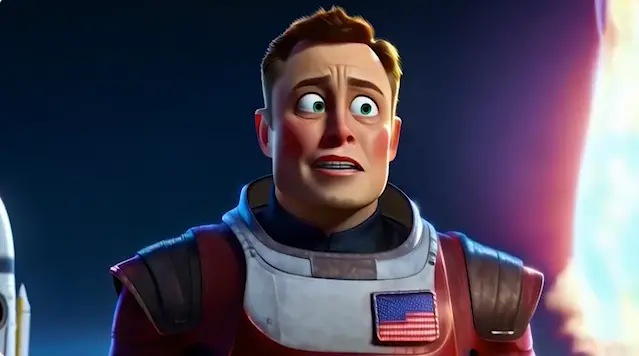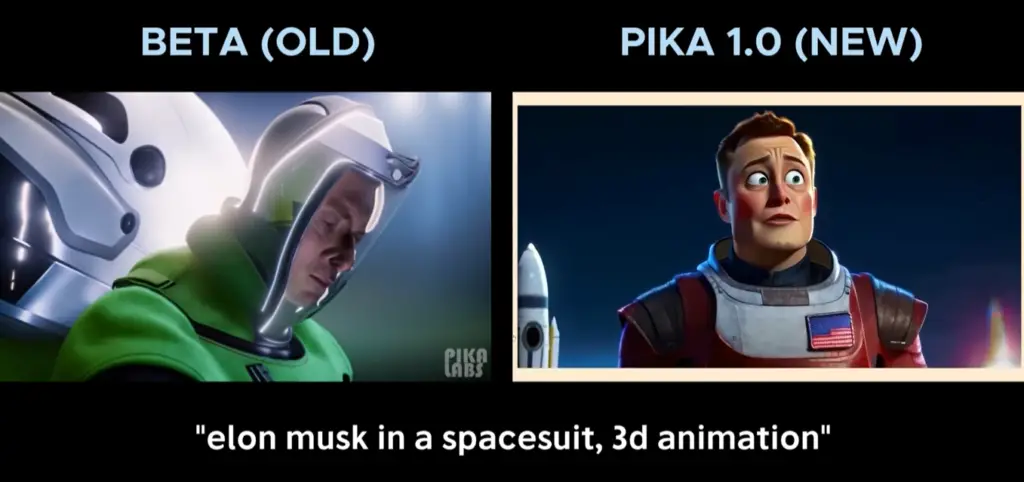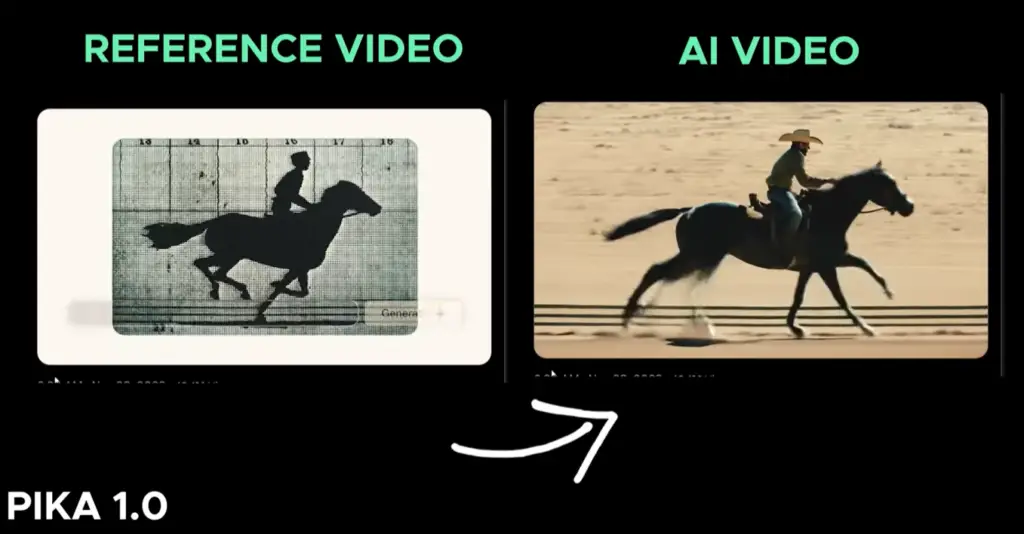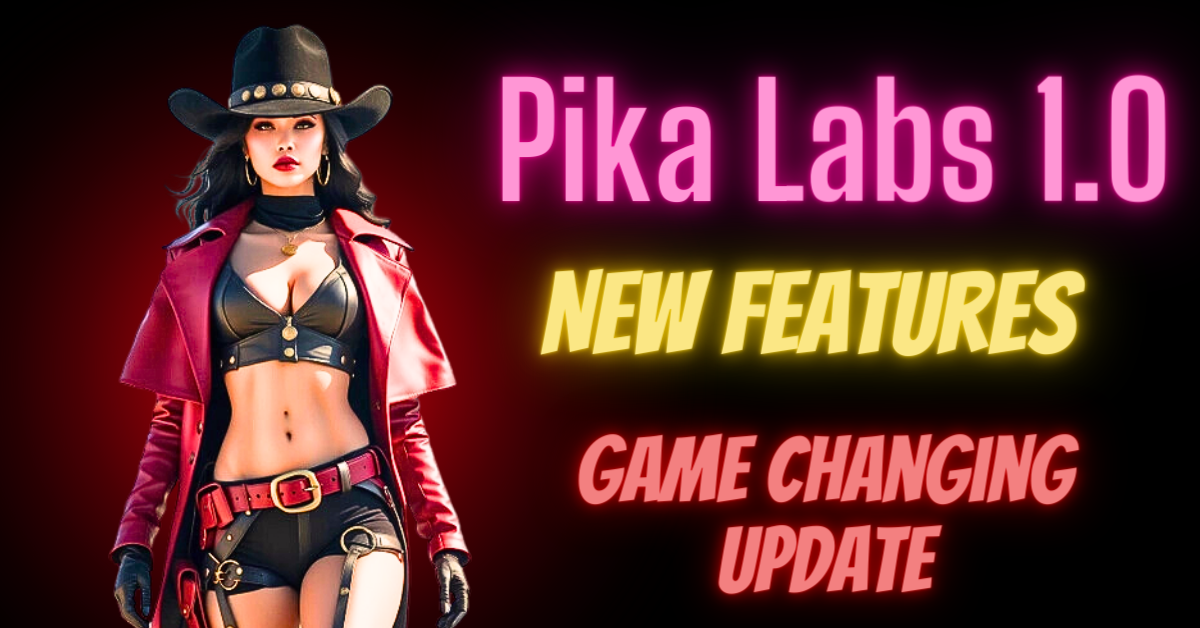The much-anticipated Pika 1.0 announcement trailer just dropped, and it’s teeming with exciting new features that promise to boost the AI video generation game to new heights. Let’s dive into the breakdown of what this latest iteration has in store for us.
Pika’s Evolution: From Beta to Official Release
The current Pika version has been in its beta phase, diligently crafted by a dedicated team. Now, with the imminent official release, the announcement trailer offers a compelling glimpse into the strides made by the Pika Labs team.
- The trailer shows an eye-catching display of text-to-video generation, showcasing the AI’s ability to render a prompt into a video with impressive fidelity.
- Highlighting the advancements, the trailer flaunts a rendering of Elon Musk in a stylized 3D animation, emphasizing the substantial improvements in anatomy and realism achieved in Pika 1.0 compared to the beta version.

Meet the Minds Behind Pika Labs:
Pika Labs was founded in April 2023 by Demi Guo and Chenlin Mang, both former Stanford classmates pursuing computer science Ph.D.s. Demi, having previously been the youngest employee at Meta AI Research, earned numerous awards in software development during her tenure.
Inspired by Runway, a generative AI video startup, and their $1.5 billion valuation, Demi and Chenlin submitted an AI film to Runway’s 2023 AI film festival but unfortunately didn’t win.
The duo, frustrated with Runway’s UI, envisioned doing things differently and set out to create Pika. Launched initially on Discord as a free beta, Pika Labs quickly gained popularity, attracting over 500,000 users within a year and securing $55 million in funding from prominent strategic investors in the generative AI space.
Prompt Comparison: Pika Beta vs. Pika 1.0
The trailer underscores the stark contrasts between the beta version and the new 1.0 release, particularly in terms of video rendering fidelity:

Detailed comparisons reveal significant differences in anatomy and structure, manifesting in more coherent and realistic compositions in Pika 1.0 videos.

Various prompts, from a floating cow in space to an anime-style girl in the forest, demonstrate marked enhancements in quality, emphasizing sharper visuals and improved stylization.
Image-to-Video Rendering
The trailer briefly touches on the image-to-video functionality:
While the trailer hints at image-to-video capabilities, it offers only a fleeting glimpse, leaving much to the imagination.
Nonetheless, Pika has historically delivered a commendable performance in image-to-video conversion, albeit the challenge of accurately rendering dynamic human motions without reference images remains.
Video-to-Video AI:
The spotlight shines on the innovative video-to-video feature:
- Pika’s introduction of video-to-video capabilities opens up many possibilities, allowing users to upload reference videos and generate new ones.

- The AI’s prowess in capturing motion from reference videos appears promising, akin to mechanisms observed in other platforms like anime diff and control net for stable diffusion.
AI Video Outpainting & Inpainting:
The trailer reveals the amazing AI video outpainting and inpainting functionalities:
Outpainting, a feature familiar in image AI, expands into the domain of videos, providing multiple aspect ratios for creative exploration.

Inpainting, a feature seldom seen in video AI, tantalizes with its ability to modify existing videos, demonstrating the addition and alteration of clothing items on a subject.

Future Expectations and Considerations
While these advancements evoke anticipation, crucial details like video duration and subscription plans for Pika 1.0’s official release remain undisclosed.
The trailer omits multi-person interaction capabilities, a feature that garnered attention in other AI platforms, leaving room for speculation on Pika’s potential expansions.
Introducing Pika 1.0, the idea-to-video platform that brings your creativity to life.
— Pika (@pika_labs) November 28, 2023
Create and edit your videos with AI.
Rolling out to new users on web and discord, starting today. Sign up at https://t.co/JHRrinsIwx pic.twitter.com/Rve3I2FzmK
Pika 1.0 New Features:
1. Video-to-Video Transformation
An unexpected but impressive addition is the ‘video to video’ feature, enabling the transformation of an existing video into a different style using a text prompt. Pika Labs seems to have polished this feature remarkably well, rivaling early versions seen in Runway and other platforms.
2. AI-Powered Aspect Ratio Manipulation
Acknowledging the needs of content creators across various platforms like TikTok, Instagram, and YouTube shorts, Pika Labs offers AI-powered aspect ratio manipulation. This feature utilizes generative AI to expand the video canvas seamlessly, ensuring optimal display across different formats.
3. Generative Fill Editing Tools
Pika Labs introduces generative fill editing tools, enabling the replacement of individual objects within a scene based on user prompts. Though in an early stage, this feature holds promising implications, particularly in product advertisements.
4. High-Quality CGI Animation
Pika Labs showcases high-quality CGI animation that approaches the level of industry giants like Pixar or DreamWorks. The lifelike expressions, nuanced lighting, and easily identifiable celebrities mark a significant leap in text-to-video technology.
5. Clip Length Extension
Addressing a major user concern, Pika Labs now allows users to extend clip lengths beyond the previous 3-second limit. While the exact mechanics are still under clarification, it appears to function similarly to Runway’s clip extension feature.
Conclusion on Pika 1.0 release:
In conclusion, the Pika 1.0 announcement trailer offers a glimpse into the exciting evolution of AI-powered video generation. While it showcases impressive improvements, it’s essential to approach these previews with a balanced perspective, understanding that cherry-picked videos might not fully represent the breadth of capabilities or potential limitations.
As we eagerly await the official release, it’s evident that Pika Labs is striving to strike a balance between motion and quality, setting itself apart from its counterparts in the AI video generation.
